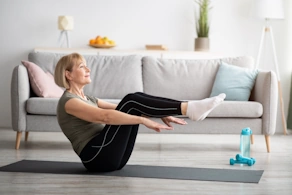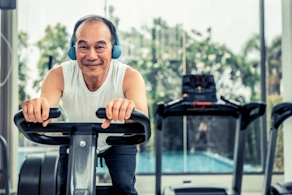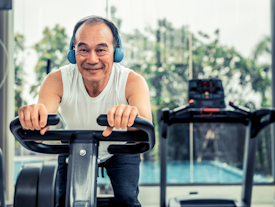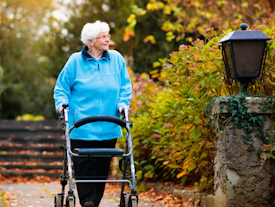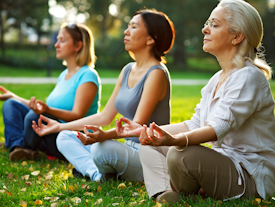Best Mobility Exercises For Seniors: Simple Moves To Improve Range Of Motion
Maintaining mobility helps support independence, balance, and overall well-being. Natural changes in strength, flexibility, and coordination can make movement more challenging over time. However, incorporating simple mobility exercises into a daily routine can help seniors stay active, reduce the risk of falls, and make everyday tasks easier.
Mobility exercises focus on improving flexibility, balance, strength, and range of motion. Designed to be gentle yet effective, these movements help older adults maintain or regain mobility safely. Whether practiced at home or in a fitness class, they contribute to a more active and confident lifestyle.
Explore some of the best mobility exercises for seniors, along with practical tips for building a consistent and effective routine.
Life Assure Product Quiz
Find The Perfect Medical Alert Device
Take our 30 second quiz and discover which Life Assure medical alert device is the right fit for you or a loved one.
Life Assure Product Quiz
Find The Perfect Medical Alert Device
Take our 30 second quiz and discover which Life Assure medical alert device is the right fit for you or a loved one.
The Importance Of Mobility For Seniors

For Canadian seniors, staying mobile isn't just about being able to move around easily—it's about maintaining independence and enjoying life to the fullest. As the body ages, muscles may weaken, joints can stiffen, and balance often becomes trickier. These changes can make everyday tasks such as getting out of bed, climbing stairs, or walking challenging, but that's where mobility exercises come in.
Regular movement helps seniors tackle common mobility hurdles head-on. One of the biggest concerns for older adults is the risk of falls, which can lead to serious injuries and a loss of independence. By improving balance and coordination through targeted exercises, seniors can significantly reduce their fall risk and enhance their independence.
Preparing For Mobility Exercises
Before starting any new exercise routine, seniors should consult their healthcare provider to ensure the chosen activities are safe and suitable for individual health conditions, such as arthritis, osteoporosis, or balance issues. A doctor or physical therapist can provide personalized recommendations, helping seniors avoid injury and achieve better results.
To create a safe and comfortable environment, seniors should:
- ● Wear supportive, non-slip footwear to maintain stability.
- ● Exercise on a flat, clutter-free surface to reduce the risk of tripping or slipping.
- ● Keep a stable chair, countertop, or wall nearby for additional support during balance exercises.
- ● Stay hydrated and avoid exercising in extreme temperatures to maintain comfort and safety.
By preparing properly, seniors can confidently approach their mobility exercises and focus on achieving gradual, positive progress.
Effective Mobility Exercises For Seniors
A mix of targeted exercises can help seniors maintain and improve mobility. Focusing on flexibility, balance, strength, and range of motion supports a healthier and more active lifestyle.
Stretching Exercises
Stretching helps maintain flexibility, reduce stiffness, and support joint health. Simple stretching exercises include:
- ● Seated Toe Touches: Sit on a chair with feet flat on the floor. Gently bend forward, reaching toward the toes while keeping the back straight. Hold for a few seconds, then return to the starting position.
- ● Neck Stretches: Sit or stand comfortably. Gently tilt the head to one side, bringing the ear toward the shoulder. Hold, then switch sides. This stretch eases neck tension and improves flexibility.
Balance Exercises
Balance exercises reduce the risk of falls by enhancing stability and coordination. Consider these effective options:
- ● Standing on One Foot: Hold onto a sturdy chair or wall for support. Lift one foot off the ground and balance on the other for 10–15 seconds. Switch legs and repeat.
- ● Heel-to-Toe Walk: Walk in a straight line by placing the heel of one foot directly in front of the toes of the other foot. If needed, use a wall for support.
Strengthening Exercises
Strengthening exercises build muscle to support mobility and reduce fall risk. Gentle exercises to add to your routine are:
- ● Chair Squats: Sit at the edge of a chair with feet shoulder-width apart. Push through the heels to stand up, then slowly sit back down. Repeat 8–10 times.
- ● Wall Push-Ups: Stand facing a wall, arms extended. Lean forward, placing palms on the wall. Bend elbows to bring the chest toward the wall, then push back to the starting position.
Aerobic Exercises
Aerobic activities boost cardiovascular health and endurance. Low-impact choices to consider:
- ● Walking: Regular walking, indoors or outdoors, improves heart health and leg strength.
- ● Water Aerobics: Exercising in water offers resistance while being gentle on the joints, making it ideal for seniors.
Flexibility And Range Of Motion Exercises
Flexibility exercises keep joints limber and enhance movement. Try:
- ● Gentle Yoga Poses: Seated or standing poses, such as the seated forward bend, help improve flexibility.
- ● Arm Circles: Stand or sit with arms extended to the sides. Make small, controlled circles to increase shoulder flexibility.
These exercises are designed to be accessible and safe for aging adults. A well-rounded routine that includes stretching, balance, strengthening, aerobic, and flexibility exercises can significantly enhance mobility and overall well-being.
Tips For Staying Motivated And Consistent

Staying motivated to exercise regularly can be challenging, but simple strategies can help seniors maintain a steady routine and enjoy the benefits of improved mobility.
- ● Set Realistic Goals: Start with small, achievable goals and gradually increase the intensity or duration of exercises over time. Celebrating progress, no matter how small, can boost motivation.
- ● Create a Routine: Scheduling exercise at the same time each day helps establish a habit.
- ● Engage in Group Activities: Participating in fitness classes or joining walking groups offers social interaction and encouragement. Group settings also provide a sense of accountability.
- ● Mix It Up: Avoid monotony by alternating between different types of exercises. Combining stretching, strength, and balance movements keeps the routine engaging and targets various aspects of mobility.
- ● Use Reminders: Setting phone alarms or placing sticky notes in visible areas can serve as helpful prompts to exercise.
- ● Celebrate Success: Rewarding oneself with a favourite activity or treat after completing a workout can reinforce positive behaviour.
By integrating these tips into their daily lives, seniors can maintain an active lifestyle, enhance mobility, and enjoy greater independence and well-being.
Conclusion
Regular mobility exercises help seniors improve strength, balance, and flexibility, promoting independence and overall well-being. For Canadian seniors, maintaining an active routine can enhance confidence, vitality, and daily comfort.
Start incorporating these exercises today for a more active and fulfilling lifestyle!











 Get Help With The Push Of A Button
Get Help With The Push Of A Button

